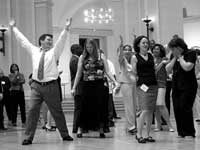
Principals
in Training
Create Arts Curriculum at Brooklyn Museum
by
Joanne Kontopirakis
At the Brooklyn Museum,
principals in training are in session, instructed
in incorporating an arts education into the school
curriculum. Seated adjacent to a giant pair of black
sculpted, seemingly sequined tap shoes, they have
broken into small groups, immersed in a guided discussion
of art objects.
Their
training, underway for the past 14 months, will
ultimately culminate in the assignment of a school
for the ’04-’05
school year. This is just one of the many seminars
they have attended via the N.Y.C. Leadership Academy
Aspiring Principals Program. During the summer, this
training will be an intensive four days a week with
a variety of topics. During the school year, participants
are in residency with a mentor principal. Additionally,
they attend the Academy for developmental sessions
Tuesday evenings and a full day Friday.
We
now observe them in discussion, after which they
barely take a break. The 77 people in the program
now enter the museum’s
Egyptian Room divided into groups. Suluh Lukoskie,
of the NYC Leadership Academy, explained that three
of the aspiring principals have designed this particular
seminar, entitled, “Your School As Canvas.”
Gloria
Cones, a school program manager, was looking on.
Asked if this was an indication that funding for
the arts in public schools will now see an increase,
she replied, “I definitely think so. There’s
a new request for proposals (RFP). Schools will
be able to ask for various programs now.”
Due
to a new vision for arts education in NYC by the
Chancellor, a mandate to develop a sequential K-12
curriculum has been issued, ensuring access to
a quality arts education for every child. In a
groundbreaking collaboration, artists from the
cultural community and educators will work side
by side to launch the process.
Donating
their time this evening in the area of dance facilitation
was David Marquis Studios. Starting in 1977, they
have employed over 30 professionals to perform
for students. David Marquis remarked, “We
have 110 schools, 21,000 NYC school children and
6,000 teachers. We’ve grown a lot in 27 years.” Marquis
continued: “The arts promote higher-level
thinking skills. I think it helps them do better
on tests. Some of these things are learned
in an internal, physical way.”
Lauren
Kraus, leading the movement exercises, announced
to the group: “Music,
dance and theatre are just as important to our students
as any other academic subjects. They are essential
to all our student’s learning. Too many of
our students are sedentary, content to sit back and
listen to music instead of creating it themselves.” “We
must model the enthusiasm for our students. Take
off your shoes and join in a dance experience that
stimulates our brain, our bodies, and our spirits.”
At
this point, the assembly was encouraged to remove
shoes and jackets, and put down their briefcases.
The whole group spread on the museum’s wooden
and buffed mosaic floors, and bobbed their heads
every which way, in unison, to an African drumming
accompaniment. People whooped and thumped in a
circle, and applauded at the end of the sequence.
Dr.
Sharon Dunn, senior instruction manager for Arts
Education, demonstrated how to use the arts resources
of the City to support the teaching curriculum.
She underscored the importance of the arts standards
of ‘doing’, ‘understanding
and utilizing materials’, ‘analyzing
and understanding art’, and ‘understanding
the contributions of the arts.’
“We have developed
a beautiful K-12 curriculum,” she stated. Use
your resources to pool with other schools. By the
time students are in the 12th grade, they should
have their own drawing style. We will also be training
music teachers. We want children to be familiar with
words like ‘crescendo,’ and not singing
a song from printed words, but understanding musical
notation.
The
final words of the evening were inspirational: “your school is
a canvas. In September you will take on the role
of architects of schools. Your success as principals
may hinge upon the arts.” #
